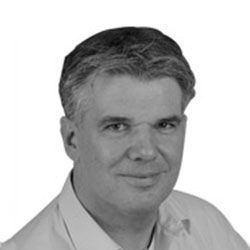


Kai Poehler

Within Voith Paper, we are in the business line projects, globally responsible for wet-laid nonwovens and specialty paper and banknote paper. More than 33 per cent of our hydroformer (inclined wire) is for the glass mat industry. This industry is traditionally growing by five to eight per cent every year.
For glass mat, it is definitely the United States of America, followed by Europe. For Wet-laid and spunlaced nonwoven WLS, the interests are global, while most lines are being sold in China currently.
Our growth mainly is in WLS. We have been very successful in the last two years. We have been able to increase our sales for hydroformer lines by 100 per cent. We expect two new lines in the market every year into the future.
On an average, we are investing around six per cent in R&D. The focus is on wet-laid process technology at the Voith wet-laid technology centre in Düren, where new end-products can be developed and debugged and their manufacturing can be verified on an inclined wire. The centre also develops and tests new units and individual machines for the wet-laid process. The hydroformer headbox has a formation width of 500 mm and is designed for a speed of 600 m/min. Trials can be carried out at speeds of between 10 m/min and 600 m/min and at basis weights of between 7 and 2000 g/m². The technology centre is equipped with two pulpers, three machine chests, a refiner and deflaker. The hydroformer headbox and closed white water loop are suitable for 1-, 2- and 3-ply tests. The paper and/or wet-laid nonwovens can be mechanically dewatered and reeled up with residual moisture content. These rolls (300-400 m) are suitable for transportation, such as for subsequent downstream processing. The inclined wire angle and relative angle of the loading board to the formation zone are adjustable so as to allow the best setting for different products to be identified. In the Wet-laid Technology Centre, tests on the inclined wire can be done under production conditions. The investment risk can thus be minimised. In addition, operating parameters can be determined to prepare for system commissioning at the customer's paper mill. The clothing can also be tested and optimised beforehand. Due to the very low stock consistency of 0.01 - 0.1 per cent, the hydroformer is especially suitable for the production of long fibre papers and wet-laid nonwovens. Key physical parameters can then be measured and evaluated in the adjacent laboratory.
The realisation of the new WLS process within less than two years, from the first ideas to the successful acceptance of a new line, is a tremendous success. The real innovation behind it is the combination of paper making knowledge with the nonwoven world. Specially, but not limited to, flushable wipes, this process opens multiple options for the product designer. We are convinced that this technology will also have an influence on the legislation and standardisation. With WLS, we will be able to produce flushable products only based on natural biological resources.
We do expect the property 'flushable' will not be limited to wipes. It can be an add-on for many other applications also.
The trend definitely is to use the available resources in more economical way. This starts with energy as already fixed in the TAPPI roadmap. But it will also reflect to the kind of raw materials we are using in products (renewable vs petroleum-based) and water usage. As our process is wet, we are currently developing a new energy efficient drying process.
With almost 80 hydroformer installations, we are by far the market leader. As in wet-laid nonwovens, almost every line is different.That huge figure does reflect an outstanding experience and engineering knowledge for wet-laying.
Sustainability is of a high importance at Voith. With our concept of sustainability, we are carrying on the tradition and style of Voith --- a family-owned company --- which includes the obligation to conduct environmentally compatible, clean and fair business with long-term success.
DISCLAIMER: All views and opinions expressed in this column are solely of the interviewee, and they do not reflect in any way the opinion of technicaltextile.net.